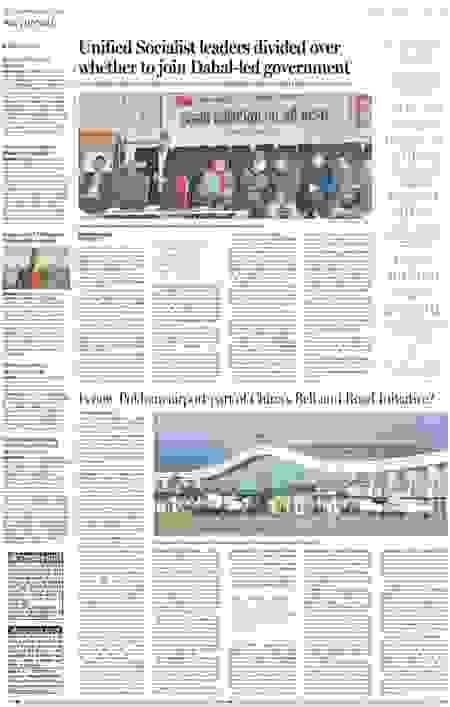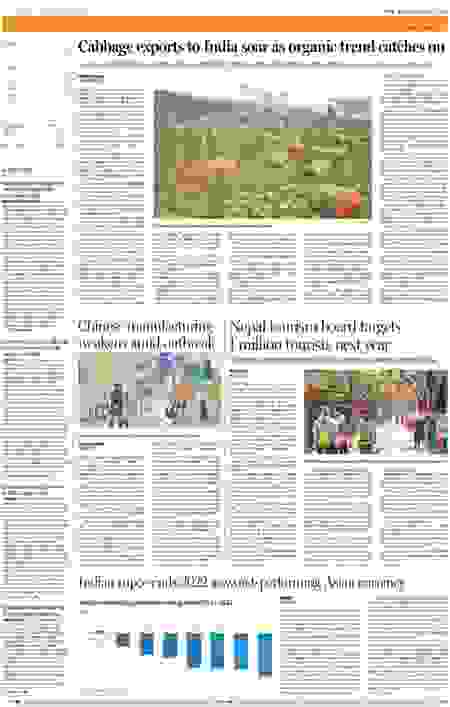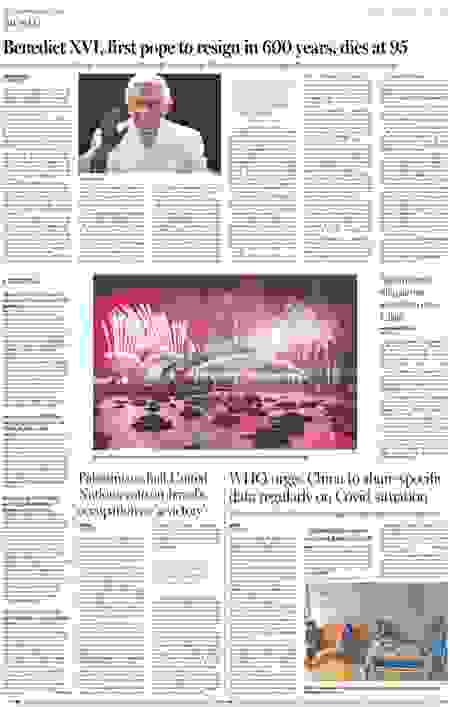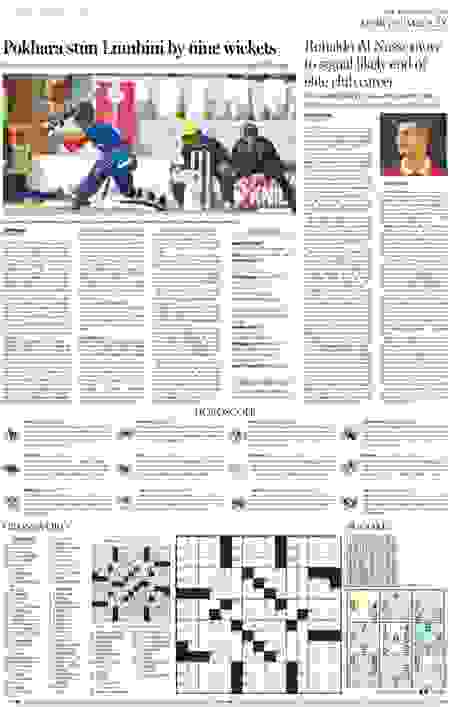Is the new Pokhara airport under China’s BRI radar?

Prime Minister Pushpa Kamal Dahal is scheduled to inaugurate the Pokhara International Airport on Sunday.File photo: RSS
KATHMANDU : At a time when Kathmandu says no project under Beijing’s Belt and Road Initiative has been signed and Nepal and China are working to finalise the text of project implementation under the BRI, the Chinese Embassy in Kathmandu made a surprise announcement on Saturday.
Just a day ahead of the inauguration of Pokhara International Airport by Prime Minister Pushpa Kamal Dahal, the Chinese Embassy wrote in its Twitter account that “This [Pokhara airport] is the flagship project of the China-Nepal BRI
cooperation.”
The airport inauguration ceremony is scheduled to start at 11 am on Sunday. The Chinese Embassy also congratulated the Nepali government and people on the connectivity milestone.
After Nepal and China signed the framework agreement on BRI in 2017, Nepal had initially selected 35 projects to be undertaken under Chinese President Xi Jinping’s flagship connectivity project. Later, upon Beijing’s request, the total number of projects was whittled down to nine with Pokhara airport off the list.
The government signed a $215.96 million soft loan agreement with China in March 2016 for the construction of the new airport in the lake city.
The loan agreement between the Civil Aviation Authority of Nepal and China EXIM Bank does not mention the BRI.
In May 2014, two years before the loan was agreed, China CAMC Engineering was given the construction contract, at a time when China’s BRI was in a nascent phase. Chinese President Xi first announced the idea of BRI in 2013 as ‘One Belt, One Road’.
China’s Exim Bank had agreed to provide 25 percent of the loan free of interest and set the interest rate at two percent per annum for the rest of the amount, with a payback period of 20 years.
At least three officials from the Ministry of Foreign Affairs, Ministry of Finance and Ministry of Tourism told the Post that loan negotiation for the project had begun before the BRI was conceptualised in China.
The Chinese Embassy’s claim, therefore, is their own interpretation, which the Nepali side does not own up, they said.
Even when the project completion ceremony of the Pokhara airport was held in Kathmandu during Chinese Foreign Minister Wang Yi’s visit in March last year, there was no mention from either side of BRI in connection with the airport.
If the Chinese Embassy says that this airport is built under BRI, this is their definition, a foreign ministry official said. “What we have agreed as of now is that China will fund two other projects under the BRI.”
According to the official, the feasibility study of Nepal-China cross-border railway and Nepal-China cross border transmission line will be funded under the BRI modality, as agreed by the two sides. A six-member Chinese team arrived in Kathmandu last week and is preparing to carry out the feasibility study of the cross-border railway, probably starting next week, with the Chinese grant.
It will take more than 42 months to complete the feasibility study of the proposed 72-kilometre railway line that will connect Kathmandu with China’s border port of Kerung.
Nepal and China are also thinking of building the Ratmate-Rasuwagadhi-Kerung transmission line. A joint technical group comprising representatives of the Nepal Electricity Authority and the State Grid Corporation of China held two rounds of talks, in China and then in Nepal, for the transmission line before the start of the Covid pandemic. According to the NEA, once built, the cross-border line will open an alternative market for Nepal’s surplus power.
Currently, India is Nepal’s only foreign market for electricity trade. India allows Nepal to sell a maximum of 452MW electricity from 10 hydropower projects. The 400 kV transmission line from Ratmate to Kerung will allow power trade between Nepal and China, the NEA said in its annual report for 2021-22. The project’s Environment Impact Assessment (EIA) is currently underway.
“Pokhara airport was conceived of long ago and as per our rather in-depth conversations with the Chinese side, it does not fall under the BRI framework,” the official added. “But the thing is, now, all kinds of Chinese assistance either in the form of loan or grant, or any project undertaken or completed by the Chinese, are being defined as falling under the BRI.
As per our definition, this particular project does not fall under the BRI framework.”
Officials from the two countries are now finalising the text of BRI implementation where financial, technical and other inventories of each project would be fixed. The previous Sher Bahadur Deuba government communicated to the Chinese side that Nepal does not want loan and preference would be given to grant considering the size and nature of Nepal’s economy.
If unavoidable, a loan should come with the interest on par with a multilateral lender or not exceed one percent per annum. In most cases, the interest rate of projects under the BRI is two to four percent. The Deuba government also made clear that Nepal is not in a position to take commercial loans to fund the project.
The Nepali side is also looking for a similar arrangement for the repayment of loans under the BRI, extending the period to 40 years and beyond. Nepali officials have also called for fair and open competition among the bidders for BRI projects.
Speaking with select journalists on April 22, 2022, outgoing Chinese ambassador Hou Yanqi had said the BRI consists of both grants and commercial loans.
“It is based on a cooperative modality that includes grants and commercial cooperation,” she said.
Hou said that many of the projects that China is currently building in Nepal fall under the BRI framework.
“This [BRI] is a long project. The projects that are being constructed in Nepal under BRI have three modalities. First, it is like Gautam Buddha Airport in Lumbini where ADB has invested and Chinese contractors have worked. Second, the modality of Pokhara Airport where China’s commercial loans and grants are there and the construction company is also Chinese,” Hou said. “And the third modality is like the Tribhuvan International Airport in Kathmandu. The responsibility of improving this airport has been given to a Chinese company and the cost will be borne by the Nepal government.”
In bilateral documentation, none of these projects has gotten grants or loans earmarked BRI, finance ministry officials said.
“Publicity is one thing but in documentation or while signing the loan negotiation or negotiating the projects, the Chinese side never said Pokhara Airport falls under the BRI,” the finance ministry official added.
The Chinese Embassy in its press note has further said: “The new airport is designed and built in accordance with the standards of China and the International Civil Aviation Organization, which reflects the quality of Chinese projects, symbolises the national pride of Nepal, and becomes a remarkable sign for China and Nepal to jointly build the Belt and Road Initiative.”
“The Pokhara International Airport project was highly valued and concerned by the leaders of the two countries. … Prime Minister Prachanda [Dahal] had promoted the airport construction. When President Xi Jinping paid a visit to Nepal in 2019, the two leaders said they would work closely to promote the early completion and operation of the airport,” the embassy said. “In March this year, State Councilor and Foreign Minister Wang Yi visited Nepal and attended the completion ceremony of the construction … of the airport. Several prime ministers of Nepal also visited and promoted the project construction.”
A joint-secretary at the Ministry of Culture, Tourism and Civil Aviation said that loan negotiations for the project had begun in 2008, ruling out the BRI component in the airport. China’s CAMC Engineering first visited Pokhara in 2008 in view of its construction when Dahal was the prime minister. No document says this project falls under the BRI, the joint-secretary said.
Former Nepali ambassador to China Leela Mani Paudyal said it is difficult to determine which project falls under the BRI. “I don’t know whether this particular project falls under the framework of BRI or is funded under the BRI scheme. Of late, all Chinese investment—grant or loan—is tagged as BRI cooperation.”
By this definition, this particular project may fall under the BRI but, again, there is no clear demarcation between a BRI and a non-BRI project, said Paudyal.























